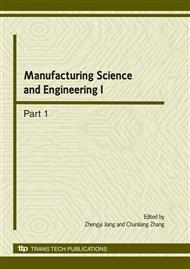[7]
which supports the established leakage prediction model represented by Eq. 9. The reason for the error between prediction results and experimental data is mainly due to the fact that different leak detection methods were used and the data in reference [7] were subject to larger error than that in the present work. 0 50 100 150 200.
Google Scholar
09 ④ ④ ④ ④ ④ ④ ④ ④ ④ ④ Leakage rate L/(Pa⋅m 3⋅s -1) a) The first group of samples b) The second group of samples Fig. 2: Relationship between leakage rate and testing time for CNA gaskets Testing time t/h Testing time t/h Leakage rate L/(Pa⋅m 3⋅s -1) Conclusions Leakage is the essential reason for the failure of gasket sealing connections. The leakage of the connections is not only related to the gasket compressive stress and the medium pressure, but also depends largely on the working temperature and service time. The experimental results of some CAN gaskets indicate that the leakage rate increases gradually with increase in service time, and it is enlarged very obviously at elevated temperatures. A time-correlated leakage prediction model of nonmetallic gasket sealing connections based on the porous medium theory was established to predict gasket leakage rates with different gasket size and various gases under different working conditions. The coefficients in Eq. 9 are constants related to gasket material, and they are obtained by regression analysis of experimental data of CNA gaskets. The established model gives relatively accurate predictions, but it is necessary to conduct additional tests in order to predict leakage rates of other types of gaskets, such as spiral wound gaskets and flexible graphite gaskets. Acknowledgements This work was supported by National Natural Science Foundation of China (10872088) and Doctoral Foundation of Ministry of Education of China (20070291004) References.
Google Scholar
[1]
B.Q. Gu, Y. Chen and D.S. Zhu: Chinese Journal of Chemical Engineering, Vol. 15(2007), pp.837-841.
Google Scholar
[2]
B.Q. Gu, X.H. Li and Z. Tian: Static sealing design technology. Standards Press of China, Beijing, (2004), pp.16-22.
Google Scholar
[3]
X. Feng and B.Q. Gu: Journal of Chemical Industry and Engineering, Vol. 57(2006), pp.2368-2371.
Google Scholar
[4]
Kececioglu, Dimitri and D. Li: In Probablilistic Structural Analysis, PVP93, ed. C. (Raj) Sundararajan, ASME, New York, (1984), pp.75-100.
Google Scholar
[5]
A.V. Tobolsky: Properties and Structure of Polymers. John Wiley and Sons, (1960), p.234.
Google Scholar
[6]
K.T. Fang and C.X. Ma: Design of orthogonal and uniform test. Science Press, Beijing, (2001), p.243.
Google Scholar
[7]
Y.L. Chen: Investigation of reliability of bolted flanged connections. Nanjing: Nanjing University of Technology (2001).
Google Scholar
09 Leakage rate L/(Pa⋅m 3⋅s -1) Testing time t/h.
Google Scholar


